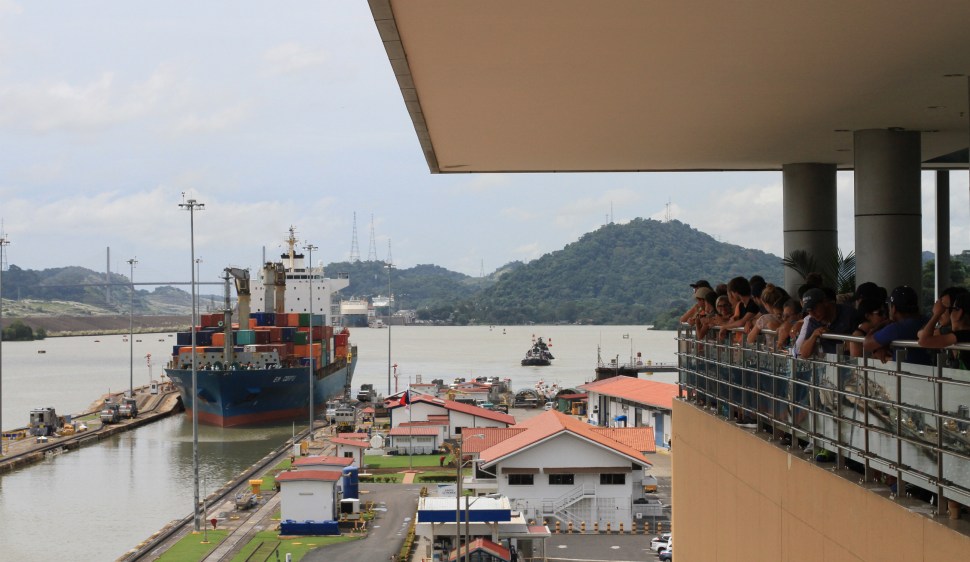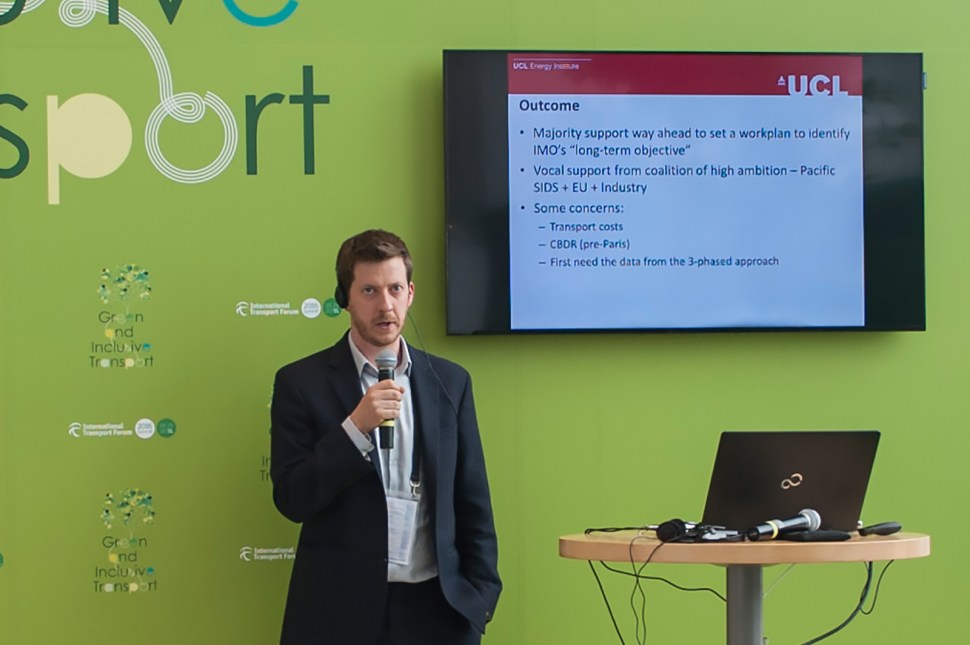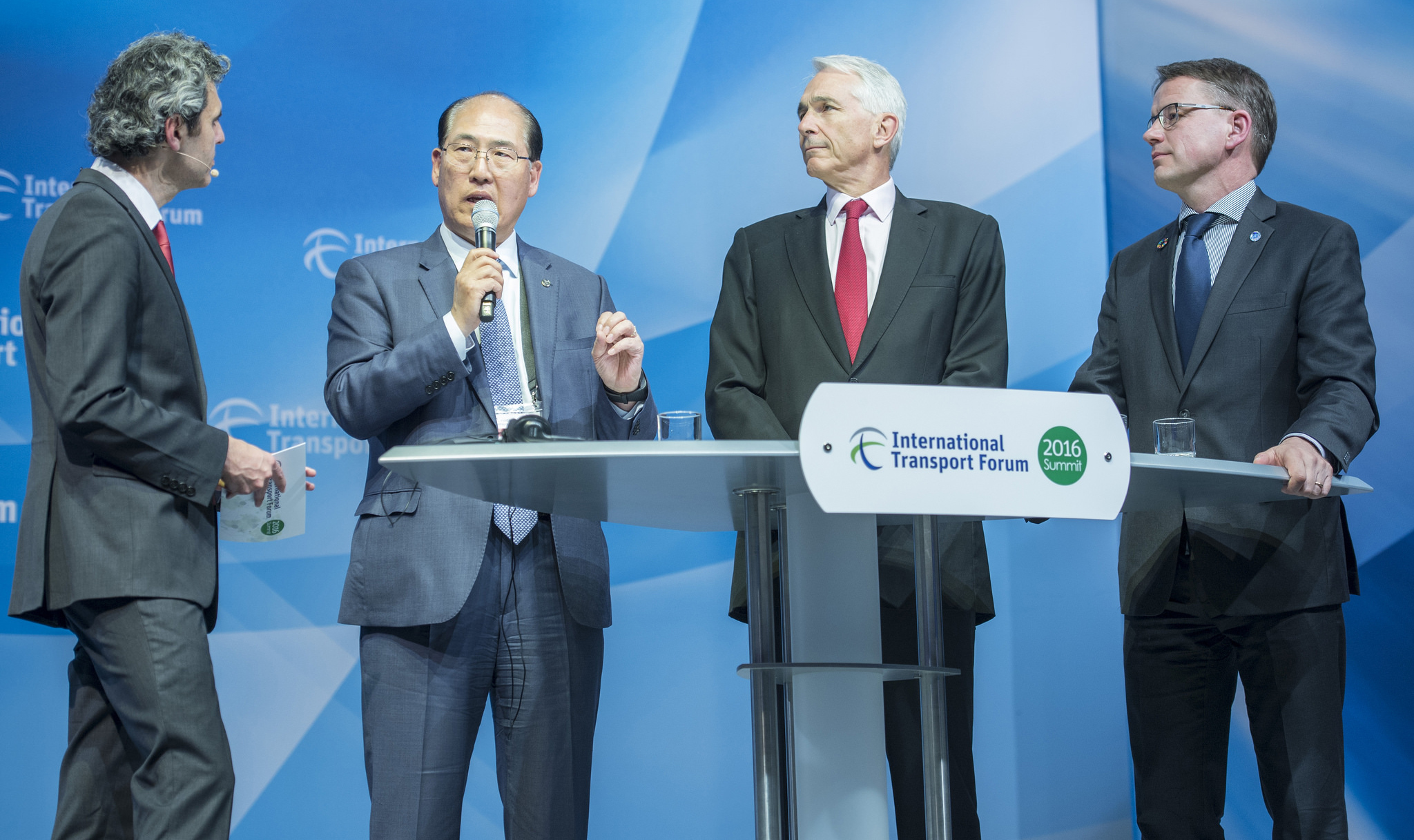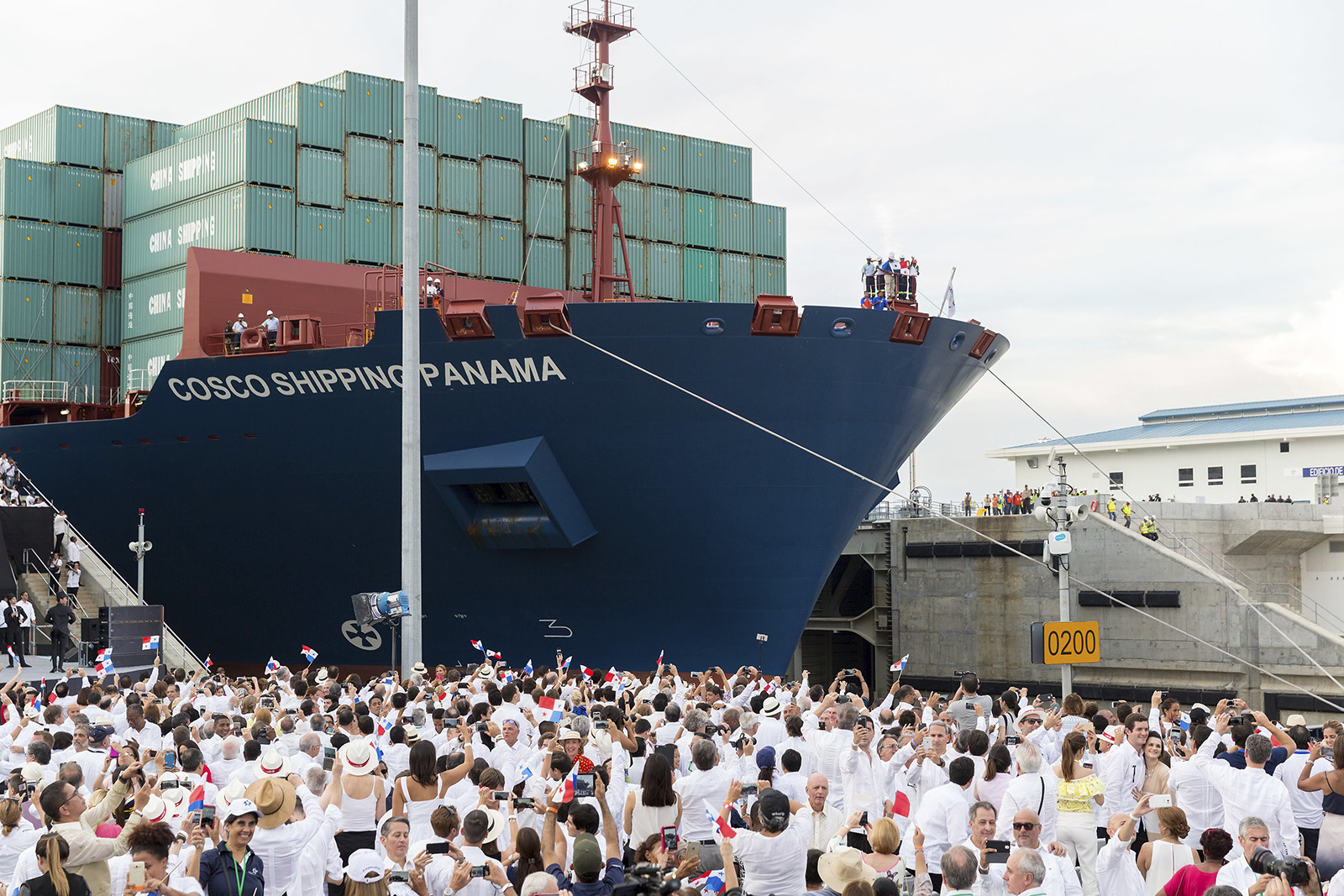The platform overlooking the Panama Canal’s Pacific exit is buzzing with energy on a muggy October afternoon. Tourists cram together, jostling for the best views of the blue container ship gliding by in the gray-green water below. The ship’s crewmembers wave from aboard the 690-foot-long vessel, smiling as they end their eight-hour, 48-mile journey.
An employee brandishing a wireless microphone — the canal’s hype man — leads the crowd in a series of cheers, his voice as bombastic as a sports announcer’s. “Let’s give them a round of applause!” he booms in Spanish and then English. The visitors heartily oblige, clapping for the sailors aboard the Greek ship named Em Corfu.
Next in line is a colossal Japanese carrier that just unloaded cars on the Eastern Seaboard of the United States. Its blue metal sides block out the sky. Behind that comes a red tanker hauling liquefied natural gas produced in the United States to terminals in Mexico.
Watching ships pass through the century-old Panama Canal offers a glimpse into our modern economy. Every day, vessels converge here to move billions of dollars’ worth of food, fuel, cars, clothing, raw materials, and electronics to the far corners of the world.
It’s awe-inspiring. But it’s also fairly alarming.
About 90 percent of everything we buy will travel on ships like these at some point. And all of these behemoths burn fossil fuel, contributing significantly to the warming atmosphere and shifting climate patterns.

Onlookers await the arrival of the Greek ship Em Corfu as it enters the Panama Canal in early October. Maria Gallucci
Many cargo ships still use “bunker fuel” — the sludgy dregs of the petroleum refining process. The noxious blend is dirt-cheap, making it possible to charge next to nothing to ship goods internationally. All of which means our unbridled consumerism hitches a ride on some of the dirtiest vehicles on earth. (At least they hold tons of stuff, right?)
The industry’s reliance on high-carbon fuel poses a major stumbling block for global efforts to rein in pollution. A few companies are ramping up investment in pilot projects that use renewable fuels and cleaner technologies. And a vocal minority within the industry is clamoring for a maritime climate policy to spur more innovation. But on the whole, there’s widespread reluctance to adopt meaningful change.
Clean shipping advocates plan to spotlight the sector’s emissions at the United Nations Climate Change Conference, which opens today in Bonn, Germany. Known as COP23, the gathering marks two years since the world agreed in Paris on a landmark climate accord — one that the Trump administration plans to abandon. The agreement, however, excluded pollution from international shipping and aviation in its targets to limit global warming. Officials had argued that those industries don’t easily fit into national or regional emissions schemes — and so they were left to regulate themselves.
Experts say regulatory action and big, bold investments will be essential to curbing the shipping industry’s contribution to global warming. Left unchecked, its carbon footprint is expected to soar in coming decades — just as emissions from cars and power plants flatline or decline. That means shipping could cancel out progress in other sectors.
The International Maritime Organization (IMO), the industry’s main regulator, suggests that carbon emissions from shipping could shoot up as much as 250 percent by 2050 as the world’s population grows and economies expand. At that point, the European Parliament estimates the industry could produce 17 percent of global emissions, up from less than 3 percent today.
But Tristan Smith, a leading shipping researcher at University College London’s Energy Institute, notes companies still have little reason to spend their time and money building a greener cargo fleet. “A very large proportion of the sector is really not interested in doing anything until the very last minute that the regulation hits,” he says.
From the Panama Canal, a string of heavily congested highways leads to Panama City’s glitzy downtown core. At a high-rise convention center in early October, hundreds of seafarers, naval officers, and industry officials have gathered for an IMO-sponsored event.
Jorge Quijano, administrator of the Panama Canal Authority, tells the crowd the canal is doing its part to “bring about a sense of responsibility with our planet.” In January, he explains, it launched a program to reward shippers that meet high energy-efficiency standards or use low-sulfur and lower-carbon fuels, including cleaner-burning liquefied natural gas. Companies that do so can boost their standing in the canal’s ranking system for determining who gets priority access to the waterway.

Tristan Smith of University College London’s Energy Institute says that, without a major regulatory push, shipping will never change its polluting ways. International Transport Forum
The industry finds initiatives like these, which encourage upgrades but not drastic overhauls, generally palatable — they promote good behavior without overtly punishing status quo ships.
But shipping executives like John Lyras bristle at the notion of setting ambitious sector-wide targets for reducing shipping emissions and total fuel consumption. Such efforts, he argued earlier this fall, won’t make any sense until cleaner maritime technologies actually exist at commercial scale.
“If we really want to reduce CO2 emissions to zero today we can do it in two ways: We can stop trading, or we can go back to sail,” the Greek shipowner said while speaking on a panel at the International Chamber of Shipping’s conference in London.
The pushback from executives like Lyras comes as more progressive voices are increasingly clamoring for the introduction of so-called “zero-emissions” ships, which don’t directly produce any greenhouse gas emissions. A research consortium comprised of major shipping companies and academic institutes asserts such vessels must start entering the mainstream cargo market by 2030. By 2050, the group says, nearly all operating cargo ships must generate zero emissions in order to fall in line with the Paris agreement goal of keeping global warming to “well below” 2 degrees Celsius, or 3.6 degrees Fahrenheit, above preindustrial levels.
Proponents say it can happen if the industry doesn’t drag its feet. “We’re not saying you have to decarbonize right now,” says Smith of University College London. “You just have to start the process of figuring it out.”
Over the next two weeks in Germany, U.N. negotiators and thousands of other participants will gather to discuss not only promising ship technologies but also strategies to convince an old-fashioned industry to embrace new ideas.
Diane Gilpin, who’s helping organize a pro-climate shipping event that will take place on the cruise ship Rhine Fantasy, tells Grist about the sector’s reluctance to go green. Gilpin once worked to introduce mobile devices to British corporations. Now, she’s leading an effort to build a 100 percent renewable cargo vessel. She says the shipping industry’s apprehension reminds her of the late ‘90s and early 2000s when many people saw the cell phones they’re now wholly consumed by as frivolous and costly.
“Because we never had cell phones before, we didn’t think we needed them,” she explains. Gilpin describes her current work trying to change the shipping industry as “a human challenge in having people accept change.”
The most prominent options for powering a ship without fossil fuels include hydrogen, batteries, sustainably produced biofuels, and wind-assisted technologies that can reduce fuel use. All of these are being used or tested in small-scale vessels — primarily passenger ferries or supply boats that keep close to shore. But if any are going to gain favor in the mainstream shipping industry, today’s reigning champion — ultra-cheap bunker fuel — will need a price tag that reflects its true environmental cost.
According to a recent report by the global shipping services company Lloyd’s Register and University College London, about 75 percent of companies agree that forcing shippers to pay for carbon emissions is required to make a zero-emissions fleet a reality. The IMO would likely oversee such a program, and it plans to adopt an interim strategy for reducing greenhouse gases caused by shipping in April 2018. But the regulatory body doesn’t expect an agreement on actual pollution targets until 2023.

International Maritime Organization Secretary-General Kitack Lim speaks at the International Transport Forum’s 2016 summit on “Green and Inclusive Transport” in Leipzig, Germany. International Transport Forum
The IMO is made up of 172 member countries. Getting all of them, as well as the world’s top shipping groups, to sign on to a set of goals would undoubtedly be a hard-fought and controversial process. Take as proof the latest round of IMO talks in October, which included discussion of slashing carbon emissions by 2100. A group of Pacific island and European nations pushed for drastic cuts by mid-century, while Saudi Arabia, India, Brazil, and the International Chamber of Shipping proposed a far less aggressive approach.
As country representatives went back and forth, InfluenceMap, a nonprofit that tracks corporations’ impact on climate policy, published a report accusing shipping lobbying groups of holding “unmatched power” over IMO decisions. Those groups resoundingly denounced the report, and IMO Secretary General Kitack Lim defended the organization’s neutrality. But one shipping executive — Andrew Craig-Bennett, who works for the U.K. subsidiary of Chinese shipping giant Cosco — stirred the pot even further in a widely shared opinion piece.
“We can feel nothing but contempt and disgust at the prostitutes employed by our racket to try to put one over on the general public,” he wrote with a sailor-worthy flourish.
Ultimately, the most effective driver for steering shipping away from its high-carbon path may come from outside the industry. The customers who place their goods on the ships are likely the best lever for forcing the sector to go green.
That’s the solution Maurice Meehan sees as a key way forward. Meehan is director of shipping operations at the Carbon War Room, a nonprofit founded by Virgin’s Richard Branson to promote business-oriented climate solutions. He previously worked with shipping giant Maersk.
As he explains, companies that produce all the T-shirts, smartphones, sneakers, and goods that are shipped around the world have substantial leverage with their logistics providers. If climate-conscious companies push their shippers to do more about reducing vessels’ carbon footprints, the industry would have to change. Dirtier ships would face a competitive disadvantage if manufacturers got serious about slashing supply-chain emissions.
“That’s a great approach,” Meehan says by phone from Copenhagen on a call in September. “Now you’ve got shipping going, ‘Whoa, wait, if we don’t have plans to meet the target our customer has set, we’re not going to be in the market in a few years?’”
Meehan says his team is talking with big users of cargo ships, such as apparel companies, to help them target shipping-related emissions. As part of that, Carbon War Room is developing tools to make it easier for companies to choose vessels with lower emissions and better efficiency — or at least ensure their products aren’t loaded onto the worst offenders.
But this approach is still in its early days, Meehan says. Most brands and shipping companies alike remain reluctant to do anything that would raise the cost of transporting goods or the final price tag. That’s largely because end users — you and me — still prefer buying a lot of cheap stuff.
If the Panama Canal illustrates the shipping sector’s climate challenge, it’s also a showcase for the industry’s progress to date. Alexis Rodriguez, the environmental protection specialist for the Panama Canal Authority, says many of the newer vessels passing through the canal today “have more efficient engines and more efficient designs.”

A container ship navigates through the Cocoli Locks in the expanded Panama Canal in late June. REUTERS/Carlos Lemos
On a recent morning, he pulled his spotless black minivan into the parking lot of the Cocoli Locks, the Pacific entrance to the newly expanded canal system. The $5.25 billion, nine-year expansion can accommodate colossal “mega ships,” like the 1,200-foot-long Theodore Roosevelt, that couldn’t pass through the original locks.
We’re here to greet a forest green container ship named Ever Living. The vessel, which is bringing Asian-made goods to ports on the U.S. East Coast, has an “optimized” hull design made from lightweight steel that makes it easier to move through water and thus cuts down on fuel use. Once docked, the ship can plug into shore-side electrical power and turn off its oil-burning engines, a process known as “cold ironing” that reduces local air pollution. Thanks to its larger-than-average size, Ever Living can also, in theory, burn less fuel and release fewer emissions for every unit of goods it carries, compared to smaller vessels.
Such upgrades are positive signs, but green fleet advocates like University College London’s Tristan Smith say a bigger, sustained push is required. Recent shipping data shows that efficiency gains might not be enough to offset rising fuel consumption and emissions in a growing industry.
Better designs and data analytics barely move the needle when it comes to decarbonizing the global shipping industry, Smith explains. “I would call them marginal improvements in efficiency, which do a tiny amount to get us nowhere near where we need to go.”
For shipping to play its part in fighting climate change, vessels crossing this canal and traversing the world’s waters will need a more radical redesign — and in just a few decades’ time. Delivering on demand for lower-emissions vessels could be the industry’s most arduous journey of all.
Maria Gallucci is the 2017-2018 Energy Journalism Fellow at the University of Texas at Austin.



